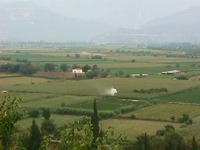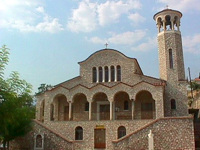Paramythia
The region of Paramythia is located at the southeast edge of the prefecture of Thesprotia. It is a at a distance of 82 km. from Ioannina and 35 km. from Igoumenitsa and its port. The town is amphitheatrically built on the foothill of mountain Koryla (altitude 1658 m.). On its southern part there is the fertile plain of Paramythia, which starts from the village of Neochori and ends up in Acheron river.
In the heart of the town flows the small and known from mythology river of Kokytos, which according to the myth was shaped by the relatives’ tears of the dead people who were guided to Hades by Charon with his boat. There are many aspects for the origins of the name. but the main one is that is comes from the word Parigoritria (from the homonymous monastery of Virgin Mary that is was located in Paramythia), “Paramytheia” in ancient greek language. Above the town, the castle of St. Donatos stands imposing in a natural fortress. It took its name by the homonymous temple that there was in the castle and it was dedicated to Donatos, the bishop of Evria (4th century A.D.), who was the protector of the castle and the wider area generally.
The first settlement in the region dates back to the Bronge Age (2.500 – 11th century B.C.) at the prehistorical location “Sardakia”, at the proximate location that is built nowadays the town of Paramythia.. Paramythia was an important commercial centre at the age of the Despotate of Epirus as long as at the Ottoman period. For the increasing of the little number of the Ottoman popuation, the Turks tried to make Islams the local population. Especially after the unsuccessful revolution by Dionysios the Philosopher, Metropolitan of Trikki, (known as “Skylosopher”) in 1611, and until the decline and fall of Souli in 1803, the Christian habitants of Paramythia were kicked out with rage.
The town, that was developed a lot until that moment, it was attacked by Ali Passia who sent away many Islam prominents who cooperated with Souliotes and executed many Christian persons. The Islam habitants of the town, who had turned to Islamic religion in their majority, spoke the Greek language, had almost the same customs and traditions with the Christian ones and knew a little about their religion. Besides many of them believed in Christian Religion in secret way. However, many churches of the region were turned into mosques.
Only the byzantine church of Virgin Mary of Paramythia has been saved. Paramythia was liberated by the Turks on February 23rd in 1913, two days after the liberation of the city of Ioannina. Despite the fact that the Christian habitants of Pramythia never created problems to the Islam habitants, the last ones cooperated with the German against the Greek during the period of the Second World War. The local people resisted with all their powers, but the price cost too much, 49 men were executed bu the German army.
Nowadays the town is full of life and traffic. Its location and the fertile flatland is the main reason for its development. It has a lot of tourist infrastucture, state services, bank, etc. Egnatia Highway which crosses the region unites it with the rest mainland of Greece and will contribute to the additional development of the region.
Sights in the town of Paramythia:
- The ruins of the ancient city of Fotiki that are located at the top of the town, at the location of Liboti
- The ruins of the medieval castle, at the settlement of Koryla
- The archaeological collection
- The byzantine church of Virgin Mary of Paramythia
- The Byzantine Baths
- Koulia
- The Venetian clock (that worked with hair and sinkers)
- The historical record of the town
Sights in the wider area:
- In Psaka: Cave of Psaka
- In Petousi: Church of St. Taxiarches
- In Prodromi: Monastery of St. Vellenis
- In Kamini: Monastery of St. Dimitrios
- In Plakoti: Monastery of Jesus Christ, a rare old church
- In Pente Ekklisies: Monastery of Virgin Mary “Ousntina”
- In Kallithea: Monastery of Paganioi of the 1652






